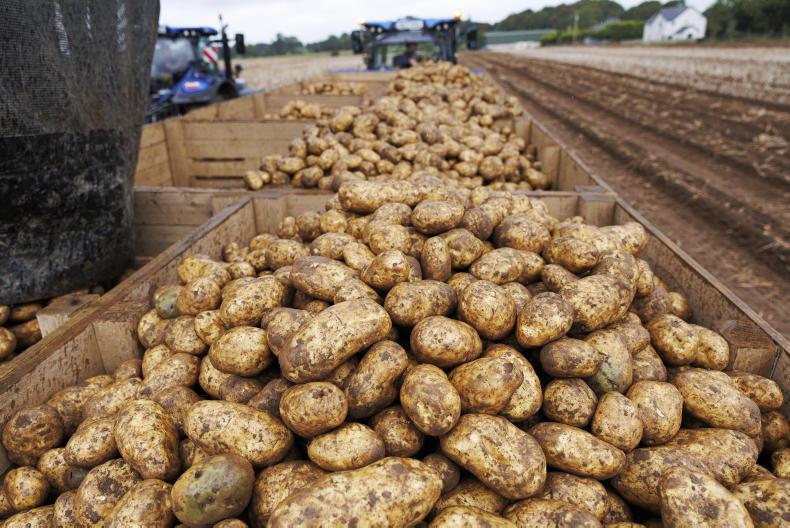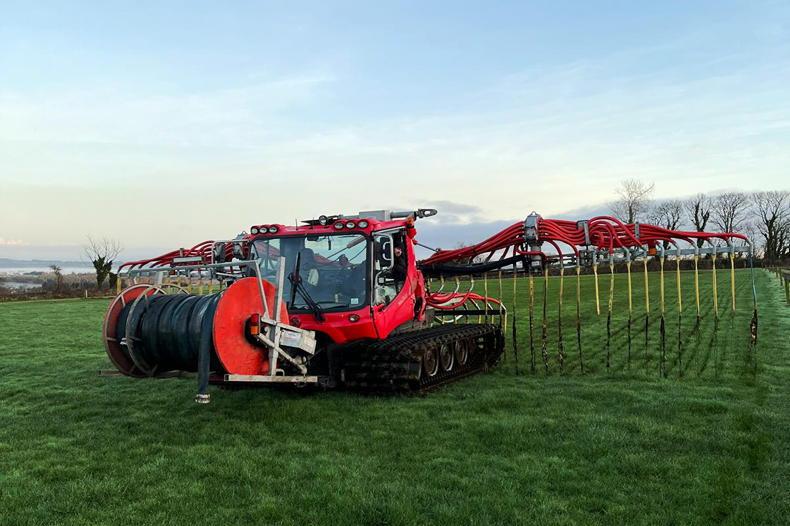Interest in multi-species swards is increasing. Once the preserve of organic or very extensive farms, more intensive farms are now expressing interest in them and most of the main grass seed companies are selling multi-species mixtures.
A multi-species sward is where a number of different species are sown together.
We are all familiar with different perennial ryegrass varieties being sown together and, while grass and clover is technically a multi-species, sowing more than two species in the one mix is a relatively new thing.
Commonly used species are perennial ryegrass, red and white clover, plantain, chicory and grass species like cocksfoot and timothy.

Plantain.
Many farmers consider most of these species as weeds, so why would other farmers be sowing them?
It’s all to do with diversity. These species have different rooting depths, so are better able to withstand droughts.
This also means that nutrients are being taken up from a different part of the soil profile so a multi-species sward can be more mineral-rich than a single-species sward.
Healthy soils
Deeper rooting varieties are an aid to drainage and aerate the soil, helping earthworms and other soil biology.
The general theory is that healthier soils will be more productive in the long term and will be better able to withstand challenges such as drought and floods.
Species such as clover fix nitrogen, so less chemical nitrogen inputs are required.

Cows grazing chicory in Australia.
Species such as plantain have been found to reduce nitrogen concentration in urine, thereby reducing nitrogen leaching. Indeed, it is for these environmental benefits that much of the interest in multi-species swards has come about.
Research of grazing dairy cows in New Zealand has found that when animals are grazed on a 100% plantain sward, nitrogen leaching reduced by 56%, and when grazed on a 50:50 plantain: perennial ryegrass sward, nitrogen leaching reduced by 33%.
A typical urine patch has a massive loading of nitrogen, up to 1,000kgN/ha, so the nitrogen reductions found in plantain is noteworthy.
When mixed with other varieties that grow well over the winter, the total reduction in nitrogen leaching can be as high as 89% as there is more nitrogen uptake in the sward and less nitrogen excreted in the urine.
Most research on multi-sward species in Ireland has taken place in the UCD Lyons Estate research farm on sheep.
The initial results showed lambs grazing six species swards were 2.4kg heavier at weaning and were drafted for slaughter on average 12 days earlier than those grazing perennial ryegrass swards.
Total growth was 10tDM/ha for the multi-species swards and perennial ryegrass swards in the 2015 and 2016 grazing seasons.

A monoculture of chicory in Australia.
In New Zealand, a monoculture of plantain sown in spring will yield about 11tDM/ha on average.
Chicory is another herb that is used in multi-species swards. Widely used as a summer crop in dry regions like Australia, it can be grazed four or five times during the summer.
However, it rarely lasts past two years. Plantain should last for two or three years while a well-managed clover sward should last for four or five years.
It’s still very much early days in the evolution of multi-swards species of pasture. There’s no doubt in my mind that multi-species swards are good for the soil.
Monocultures of any species are not diverse, and diversity is particularly important when it comes to soils. Nature designed it that way.
However, I’m not as convinced that multi-species swards are going to be the cure all for all environmental problems.
What we really need is systems research on multi-species swards. To the best of my knowledge, this has been lacking up to now.
Doing component research and modelling the outcomes, as is the norm in New Zealand, is not the same as the systems research like what happens at Moorepark and in the UCD dairy systems study.
Reducing nitrogen excretion in urine is a good result and is promising to see.
But if the multi-species sward only lasts a few years, it will need more regular cultivation and sowing compared with permanent pastures.
Every time a field is cultivated, nitrogen leaching occurs. Ploughing releases a lot of nitrogen, while minimum tillage releases a lot less.
All cultivation of soil releases carbon, so this should also be a consideration.
Pasture growth
If overall pasture growth is lower in a multi-species sward, stocking rate needs to decrease or more supplement needs to be purchased in.
Even if total growth is similar to perennial ryegrass, at what stage in the year does the growth come?
This is important as growth in summer is worth a lot less than growth at the shoulders.
What effect will both of these have on profitability and nitrogen leaching?
Feeding any type of supplement brings extra nitrogen on to the farm and increases the risk of leaching.
For me, the best multi-species swards that farmers should be considering at present is perennial ryegrass and clover.
This is proven to increase growth with less nutrient use. We need more Irish systems research on other species.
Interest in multi-species swards is increasing. Once the preserve of organic or very extensive farms, more intensive farms are now expressing interest in them and most of the main grass seed companies are selling multi-species mixtures.
A multi-species sward is where a number of different species are sown together.
We are all familiar with different perennial ryegrass varieties being sown together and, while grass and clover is technically a multi-species, sowing more than two species in the one mix is a relatively new thing.
Commonly used species are perennial ryegrass, red and white clover, plantain, chicory and grass species like cocksfoot and timothy.

Plantain.
Many farmers consider most of these species as weeds, so why would other farmers be sowing them?
It’s all to do with diversity. These species have different rooting depths, so are better able to withstand droughts.
This also means that nutrients are being taken up from a different part of the soil profile so a multi-species sward can be more mineral-rich than a single-species sward.
Healthy soils
Deeper rooting varieties are an aid to drainage and aerate the soil, helping earthworms and other soil biology.
The general theory is that healthier soils will be more productive in the long term and will be better able to withstand challenges such as drought and floods.
Species such as clover fix nitrogen, so less chemical nitrogen inputs are required.

Cows grazing chicory in Australia.
Species such as plantain have been found to reduce nitrogen concentration in urine, thereby reducing nitrogen leaching. Indeed, it is for these environmental benefits that much of the interest in multi-species swards has come about.
Research of grazing dairy cows in New Zealand has found that when animals are grazed on a 100% plantain sward, nitrogen leaching reduced by 56%, and when grazed on a 50:50 plantain: perennial ryegrass sward, nitrogen leaching reduced by 33%.
A typical urine patch has a massive loading of nitrogen, up to 1,000kgN/ha, so the nitrogen reductions found in plantain is noteworthy.
When mixed with other varieties that grow well over the winter, the total reduction in nitrogen leaching can be as high as 89% as there is more nitrogen uptake in the sward and less nitrogen excreted in the urine.
Most research on multi-sward species in Ireland has taken place in the UCD Lyons Estate research farm on sheep.
The initial results showed lambs grazing six species swards were 2.4kg heavier at weaning and were drafted for slaughter on average 12 days earlier than those grazing perennial ryegrass swards.
Total growth was 10tDM/ha for the multi-species swards and perennial ryegrass swards in the 2015 and 2016 grazing seasons.

A monoculture of chicory in Australia.
In New Zealand, a monoculture of plantain sown in spring will yield about 11tDM/ha on average.
Chicory is another herb that is used in multi-species swards. Widely used as a summer crop in dry regions like Australia, it can be grazed four or five times during the summer.
However, it rarely lasts past two years. Plantain should last for two or three years while a well-managed clover sward should last for four or five years.
It’s still very much early days in the evolution of multi-swards species of pasture. There’s no doubt in my mind that multi-species swards are good for the soil.
Monocultures of any species are not diverse, and diversity is particularly important when it comes to soils. Nature designed it that way.
However, I’m not as convinced that multi-species swards are going to be the cure all for all environmental problems.
What we really need is systems research on multi-species swards. To the best of my knowledge, this has been lacking up to now.
Doing component research and modelling the outcomes, as is the norm in New Zealand, is not the same as the systems research like what happens at Moorepark and in the UCD dairy systems study.
Reducing nitrogen excretion in urine is a good result and is promising to see.
But if the multi-species sward only lasts a few years, it will need more regular cultivation and sowing compared with permanent pastures.
Every time a field is cultivated, nitrogen leaching occurs. Ploughing releases a lot of nitrogen, while minimum tillage releases a lot less.
All cultivation of soil releases carbon, so this should also be a consideration.
Pasture growth
If overall pasture growth is lower in a multi-species sward, stocking rate needs to decrease or more supplement needs to be purchased in.
Even if total growth is similar to perennial ryegrass, at what stage in the year does the growth come?
This is important as growth in summer is worth a lot less than growth at the shoulders.
What effect will both of these have on profitability and nitrogen leaching?
Feeding any type of supplement brings extra nitrogen on to the farm and increases the risk of leaching.
For me, the best multi-species swards that farmers should be considering at present is perennial ryegrass and clover.
This is proven to increase growth with less nutrient use. We need more Irish systems research on other species.












SHARING OPTIONS